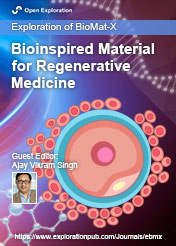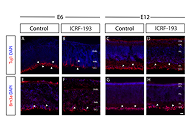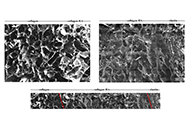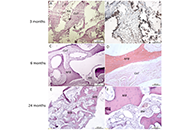
Bioinspired Material for Regenerative Medicine
Guest Editor
Ajay Vikram Singh E-Mail
Senior Scientist at German Federal Institute for Risk Assessment (BfR), Berlin, Germany.
Research Keywords: Chemical toxicology, nanotoxicology, AI & QSAR, in silico modelling, micro-nanorobotics, materials engineering & antibacterial surface design
About the Special lssue
Regenerative medicine is an interdisciplinary field that aims to develop innovative approaches for tissue repair and replacement. The field encompasses diverse disciplines such as biology, medicine, material science, and engineering to overcome the limitations of traditional medical interventions. One of the key challenges in regenerative medicine is to design and develop materials that can support cellular functions and promote tissue regeneration.
Bioinspired materials have emerged as promising candidates for regenerative medicine due to their ability to mimic the extracellular matrix (ECM) and provide a favorable microenvironment for cells to grow and differentiate. These materials can be synthesized from natural or synthetic polymers, or a combination of both, to create a scaffold that can provide mechanical support to the tissue while promoting cell adhesion, proliferation, and differentiation. The incorporation of bioactive molecules such as growth factors or cytokines can further enhance the regenerative potential of these materials.
Bioinspired materials have been widely investigated for tissue engineering, wound healing, drug delivery, and other regenerative medicine applications. For example, scaffolds made of biodegradable polymers such as polycaprolactone or poly(lactic-co-glycolic acid) have been used for bone tissue engineering due to their ability to degrade over time and be replaced by new tissue. Similarly, hydrogels made of natural polymers such as chitosan or alginate have been investigated for wound healing due to their adhesive and antimicrobial properties.
This special issue aims to provide a comprehensive overview of the latest research and development in the area of bioinspired materials for regenerative medicine. We welcome submissions covering a broad range of topics such as the design, synthesis, characterization, and application of bioinspired materials, biocompatibility, degradation properties, and commercial translation.
The key topics under which submission can be made for this special issue on Bioinspired Materials for Regenerative Medicine:
1. Toxicology:
· Evaluation of the biocompatibility and safety of bioinspired materials for use in regenerative medicine
· Assessment of the cytotoxicity, genotoxicity, and immunotoxicity of bioinspired materials
· Evaluation of the environmental impact of bioinspired materials
2. Medicine:
· Development of bioinspired materials for tissue engineering and regenerative medicine applications
· Investigation of the therapeutic potential of bioinspired materials for the treatment of various diseases and injuries
· Clinical trials and case studies of bioinspired materials for regenerative medicine applications
3. Material Science:
· Design, synthesis, and characterization of bioinspired materials for regenerative medicine
· Fabrication of bioinspired materials using advanced manufacturing techniques, such as 3D printing and microfluidics
· Investigation of the mechanical properties and degradation behavior of bioinspired materials
4. Machine Learning & Artificial Intelligence:
· Development of machine learning and artificial intelligence approaches for the design and optimization of bioinspired materials for regenerative medicine
· Use of computational modeling and simulation to predict the behavior and performance of bioinspired materials
· Integration of ML & AI techniques with experimental approaches for the development and characterization of bioinspired materials.
Keywords: Regenerative medicine, bioinspired materials, tissue engineering, wound healing, drug delivery, biocompatibility, commercial translation, extracellular matrix
Published Articles


